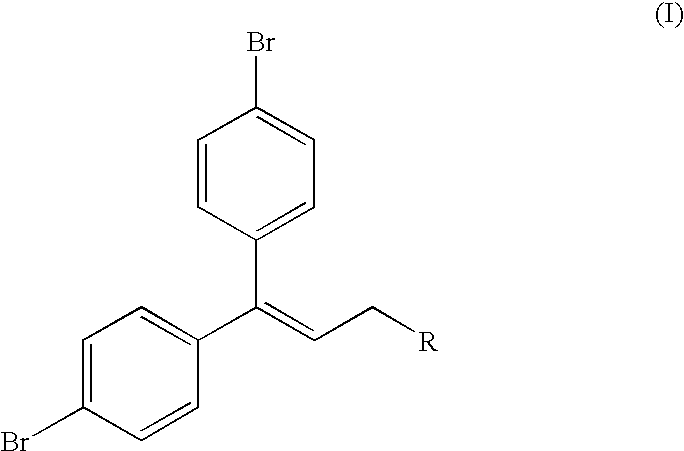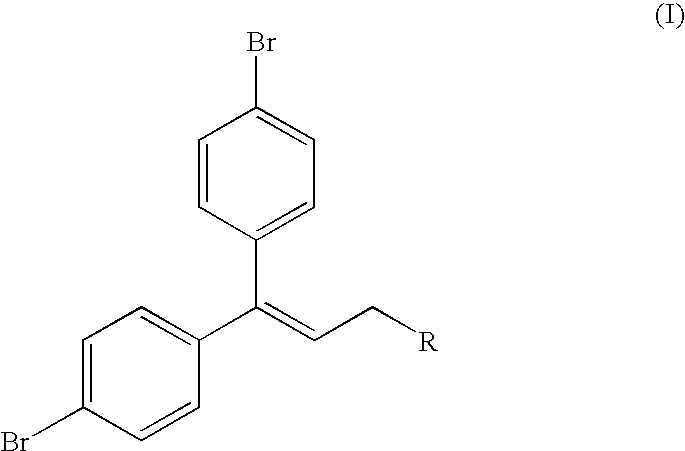Process for preparing phenoxy acetic acid derivatives
a technology of phenoxy acetic acid and derivatives, which is applied in the field of synthesizing organic chemistry, can solve the problems of ineffective single therapy, inability to overcome macrovascular complications, and inability to achieve glucose lowering as a single approach,
- Summary
- Abstract
- Description
- Claims
- Application Information
AI Technical Summary
Problems solved by technology
Method used
Image
Examples
example 1
Ethyl 3,3-bis-(4-bromo-phenyl)-acrylate
[0126]Sodium (40.6 g, 1.765 mol) was dissolved in absolute ethanol (1 L). Triethyl phosphono-acetate (395 g, 1.765 mol) was added, and the resulting mixture was stirred at 60° C. for 15 minutes. 4,4′-Dibromobenzophenone (500 g, 1.471 mol) was added to the reaction mixture and the temperature rose to 75° C. Additional ethanol (1 L) was added and the reaction mixture was stirred overnight at 70° C. The reaction was filtered while hot, and the filtrate was subsequently cooled to 10° C. Ethyl-3,3-bis-(4-bromophenyl)-acrylate precipitated, the product was isolated by filtration and the filter cake was washed with ethanol (300 mL). Dried overnight at room temperature to give 540 g ethyl 3,3-bis-(4-bromo-phenyl)-acrylate (90% yield). 1H-NMR (CDCl3): δ 7.52 (2H, d, J=8.5 Hz), 7.46 (2H, d, 3 J=8.6 Hz), 7.14 (2H, d, J=8.5 Hz), 7.07 (2H, d, J=8.1 Hz), 6.34 (1H, s), 4.07 (2H, q, J=7 Hz, CH2), 1.15 (3H, t, J=7 Hz, CH3). 13C-NMR (CDCl3): δ 166.0, 154.5, 139....
example 2
3,3-Bis-(4-bromophenyl)-prop-2-en-1-ol
[0127]To a stirred solution of 1 M DIBAL-H in toluene (1620 g, 1.888 mol) cooled to 13° C. was added a solution of the compound of example 1 (352 g, 0.858 mol) in toluene (500 mL), while the temperature of reaction mixture was kept below 25° C. HPLC after 1 h showed residual starting material, and more 1 M DIBAL-H in toluene (50 mL) was added. The resulting mixture was stirred for additional 10 minutes. Reaction mixture was transferred to a cooled mixture of conc. HCl (700 mL) in water (1.4 L), while the temperature was kept below 27° C. Layers were separated and the aqueous layer was extracted with toluene (500 mL). The combined organic layer was washed with water (2×400 mL) and concentrated in vacuo. The residue was crystallized from acetonitrile (600 mL) to afford 293 g of 3,3-Bis-(4-bromo-phenyl)-prop-2-en-1-ol (93% yield). 1H-NMR (CDCl3): δ 7.51 (2H, d, J=8.6 Hz), 7.41 (2H, d, J=8.5 Hz), 7.09 (2H, d, 3 J=8.6 Hz), 7.02 (2H, d, J=8.5 Hz), 6.2...
example 3
1,1-Bis-(4-bromo-phenyl)-3-chloropropene
[0128]To a stirred solution of 3,3-Bis-(4-bromophenyl)-prop-2-en-1-ol of example 2 (250 g, 679 mmol) in toluene (1 L) was slowly added thionyl chloride (89 g, 747 mmol). NOTE: reaction set up was connected to a scrubber to remove formed HCl(g) and SO2. The temperature of the reaction mixture rose to 32° C., and the mixture was stirred at this temperature for 2 h.
[0129]HPLC showed full conversion of starting material. Water (300 mL) was added, stirred for 30 min and the layers were separated. Toluene-layer was washed with water (300 mL) and was subsequently poured into a vigorously stirred saturated NaHCO3-solution (400 mL). Layers were separated and the org. layer was washed with water (300 mL) and concentrated in vacuo. The residue was crystallized from isopropanol (900 mL), filtered and dried to afford 203 g of 1,1-Bis-(4-bromo-phenyl)-3-chloropropene (77% yield). 1H-NMR (CDCl3): δ 7.55 (2H, d, J=8.6 Hz), 7.42 (2H, d, J=8.6 Hz), 7.10 (2H, d,...
PUM
| Property | Measurement | Unit |
|---|---|---|
| Temperature | aaaaa | aaaaa |
| Phase | aaaaa | aaaaa |
Abstract
Description
Claims
Application Information
 Login to View More
Login to View More - R&D
- Intellectual Property
- Life Sciences
- Materials
- Tech Scout
- Unparalleled Data Quality
- Higher Quality Content
- 60% Fewer Hallucinations
Browse by: Latest US Patents, China's latest patents, Technical Efficacy Thesaurus, Application Domain, Technology Topic, Popular Technical Reports.
© 2025 PatSnap. All rights reserved.Legal|Privacy policy|Modern Slavery Act Transparency Statement|Sitemap|About US| Contact US: help@patsnap.com



